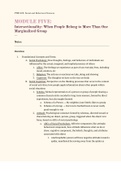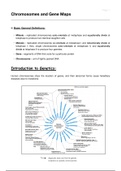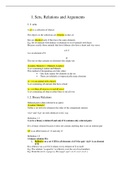CAREMA Study introduction
Study that investigates the cardiovascular incidence, etiology, and risk prediction
AMI = acute myocardial infarction
Metabolome = sugars, nucleotides, amino acids, lipids; as -omics technology the closest to
biomedical phenotypes (representation of your whole body)
Case-control study to what extent can traditional risk factors predict future CHD risk?
Case-control design: MI cases and controls (cross-sectional)
Prospective analysis people that are measured at one timepoint and then followed to see
whether they develop CVD or not
Clinical epidemiology: research question
Designing the research question:
- Can only be formulated after extensive research (literature review)
- What is the problem that you want to solve? (Focus on the problem)
- Is specific, focused
REWARD Alliance = reduce research waste and reward diligence much research is wasted
due to wrong questions, bad designs, and poor reporting
Diagnosis
- find a diagnostic method for a disease (is it the disease yes, or no?)
- look at one point in time (time of diagnosis)
- cross-sectional design (collect information of exposure and outcome at the same
time)
Prognosis/intervention
- from the disease onwards, find out if a drug works
- about the future, how long will the patient survive
- (observational) follow-up study or randomized controlled trial
Etiology
- look back in time to find the cause of the disease, past exposure
- case-control study (compare exposure history of patients with controls) or follow-up
study (retrospectively)
Problems in diagnostic/prognostic relations are bias and misclassification
Problems in etiologic/therapeutic relations are bias, misclassification and confounding
Epidemiology is the study of occurrence of illness; 4 aspects are needed for the research
question (diagnostic or etiologic study):
Search for the relation between determinants/exposure (characteristics or interventions)
and the outcome/disease (prevalence or incidence)
Domain = to whom it may concern
Time dimension = expected time from exposure to occurrence of the outcome (no time for
diagnostic studies since it is one timepoint)
Area under the ROC curve (AUC) is a measure for diagnostic value (both sensitivity and
specificity); it gives a percentage of how often the disease is correctly predicted
, PICOT is used for intervention research:
- Population = to whom it may concern (both exposed and non-exposed people)
- Intervention = determinants, exposed
- Comparison = control, non-exposed
- Outcome = disease (prevalence or incidence); defined in risk difference or odds ratio
- Time dimension
Basic epi concepts
Measure of frequency of disease:
- Absolute number
- Prevalence = proportion (number) of people in a population who have the disease
- Cumulative incidence (incidence proportion) = proportion of new people who
developed the disease during a period of time
- Incidence rate = number of subjects developing the disease / total time experienced
for the subjects followed (persons years till disease)
Measure of association:
- Absolute difference = risk exposed – risk not exposed
- Relative risk = risk exposed / risk not exposed
- Relative difference
- Odds ratio = odds sick / odds healthy = (exposed sick / not exposed sick) / (exposed
healthy / not exposed healthy)
- Attributable risk (etiologic fraction) = (risk in exposed – risk in unexposed) / risk in
exposed; how big is the chance that in exposed people the exposure caused the
disease
- Population attributable risk = (risk in population – risk in unexposed) / risk in
population; proportion that can be prevented if an intervention exists (take out an
exposure from the population)
- Number needed to treat (NNT) = 1 / risk difference = how many people should get
the treatment to save 1 person
Types of epidemiologic studies:
- Experimental
o Randomized controlled trial compare strategies (drugs, treatment).
Participants must give full consent after which they are randomized to create
similar groups (check baseline characteristics) to prevent confounding bias.
Includes follow-up (same time for everyone). Randomization can be blinded
to avoid observer bias (placebo is needed). Intention to treat analysis is done
to prevent selection bias (some patients don’t take the medicine as they
should, but for a reason, so they should stay in the analysis). Pro-protocol
analysis only uses the data that is obtained according to the protocol (now
you know what you really want to know, but selection bias).
- Observational
o Cohort study compare persons with an exposure with persons without the
exposure or with another exposure. Observational, so no randomization
which could lead to different groups thus confounding bias. Persons are
Study that investigates the cardiovascular incidence, etiology, and risk prediction
AMI = acute myocardial infarction
Metabolome = sugars, nucleotides, amino acids, lipids; as -omics technology the closest to
biomedical phenotypes (representation of your whole body)
Case-control study to what extent can traditional risk factors predict future CHD risk?
Case-control design: MI cases and controls (cross-sectional)
Prospective analysis people that are measured at one timepoint and then followed to see
whether they develop CVD or not
Clinical epidemiology: research question
Designing the research question:
- Can only be formulated after extensive research (literature review)
- What is the problem that you want to solve? (Focus on the problem)
- Is specific, focused
REWARD Alliance = reduce research waste and reward diligence much research is wasted
due to wrong questions, bad designs, and poor reporting
Diagnosis
- find a diagnostic method for a disease (is it the disease yes, or no?)
- look at one point in time (time of diagnosis)
- cross-sectional design (collect information of exposure and outcome at the same
time)
Prognosis/intervention
- from the disease onwards, find out if a drug works
- about the future, how long will the patient survive
- (observational) follow-up study or randomized controlled trial
Etiology
- look back in time to find the cause of the disease, past exposure
- case-control study (compare exposure history of patients with controls) or follow-up
study (retrospectively)
Problems in diagnostic/prognostic relations are bias and misclassification
Problems in etiologic/therapeutic relations are bias, misclassification and confounding
Epidemiology is the study of occurrence of illness; 4 aspects are needed for the research
question (diagnostic or etiologic study):
Search for the relation between determinants/exposure (characteristics or interventions)
and the outcome/disease (prevalence or incidence)
Domain = to whom it may concern
Time dimension = expected time from exposure to occurrence of the outcome (no time for
diagnostic studies since it is one timepoint)
Area under the ROC curve (AUC) is a measure for diagnostic value (both sensitivity and
specificity); it gives a percentage of how often the disease is correctly predicted
, PICOT is used for intervention research:
- Population = to whom it may concern (both exposed and non-exposed people)
- Intervention = determinants, exposed
- Comparison = control, non-exposed
- Outcome = disease (prevalence or incidence); defined in risk difference or odds ratio
- Time dimension
Basic epi concepts
Measure of frequency of disease:
- Absolute number
- Prevalence = proportion (number) of people in a population who have the disease
- Cumulative incidence (incidence proportion) = proportion of new people who
developed the disease during a period of time
- Incidence rate = number of subjects developing the disease / total time experienced
for the subjects followed (persons years till disease)
Measure of association:
- Absolute difference = risk exposed – risk not exposed
- Relative risk = risk exposed / risk not exposed
- Relative difference
- Odds ratio = odds sick / odds healthy = (exposed sick / not exposed sick) / (exposed
healthy / not exposed healthy)
- Attributable risk (etiologic fraction) = (risk in exposed – risk in unexposed) / risk in
exposed; how big is the chance that in exposed people the exposure caused the
disease
- Population attributable risk = (risk in population – risk in unexposed) / risk in
population; proportion that can be prevented if an intervention exists (take out an
exposure from the population)
- Number needed to treat (NNT) = 1 / risk difference = how many people should get
the treatment to save 1 person
Types of epidemiologic studies:
- Experimental
o Randomized controlled trial compare strategies (drugs, treatment).
Participants must give full consent after which they are randomized to create
similar groups (check baseline characteristics) to prevent confounding bias.
Includes follow-up (same time for everyone). Randomization can be blinded
to avoid observer bias (placebo is needed). Intention to treat analysis is done
to prevent selection bias (some patients don’t take the medicine as they
should, but for a reason, so they should stay in the analysis). Pro-protocol
analysis only uses the data that is obtained according to the protocol (now
you know what you really want to know, but selection bias).
- Observational
o Cohort study compare persons with an exposure with persons without the
exposure or with another exposure. Observational, so no randomization
which could lead to different groups thus confounding bias. Persons are




